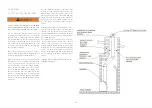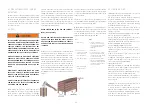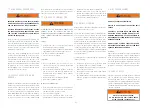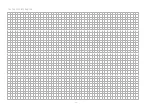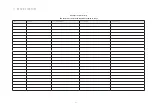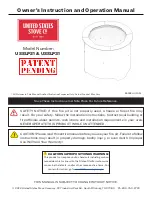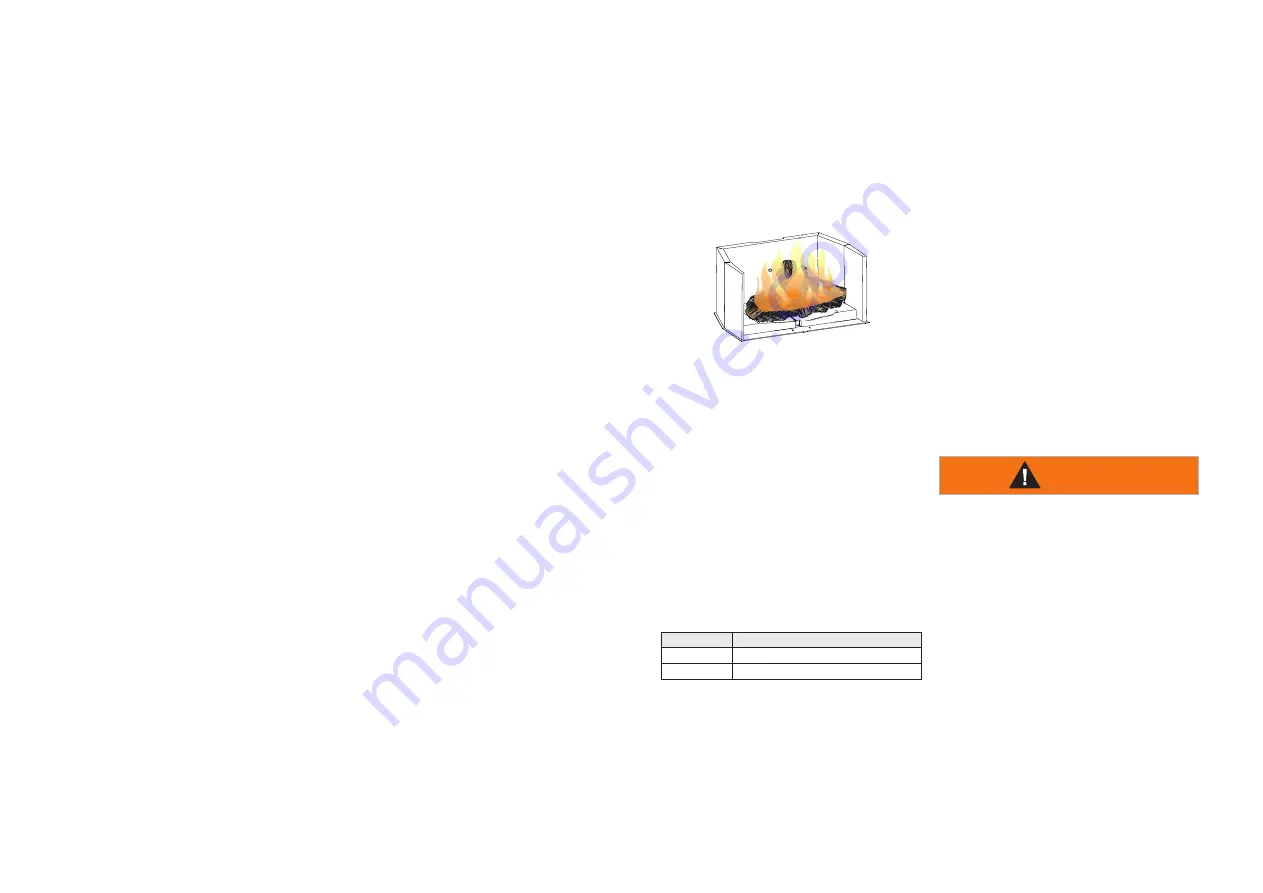
21
affect the extraction of flue gases from the wood
insert. Check the combustion air supply (if required,
open the cover flap)!
3. Adjust the combustion air regulator to the far right,
and open the firebox door (swing open).
4. Place chopped wood into the middle of the firebox
using the funeral pyre method (use softwood).
Caution: The height of the wood pile must not exceed
the lower marking on the deflector plate!
5. Place standard firelighter cubes under
the wood pyre to help start the fire. (paper is not rec-
ommended because it burns too quickly and causes
ash to circulate).
6. Never use methylated spirits, petrol, oil or other
easily combustible liquids.
7. Light the fire using the firelighter cubes and, if
required, leave the firebox door open by approx. 3-5
cm. The fire should now light, burning
brightly and intensively.
8. When the kindling wood is burning well, add smaller
hardwood logs or larger softwood logs using the
funeral pyre method and close the door.
9. When the wooden logs are burning well, the air con-
trol lever can be set to a position in the middle.
10. You can find out more about the correct volume of
wood to add to the fire in the section ‘‘Volume of wood
to add per hour’’.
Lighting the fire in your masonry insert is very easy if
you follow the instructions given below:
1. A fire may only be started in the masonry insert
when the firebox lining has been correctly installed.
2. Turn off any air extraction ventilation (kitchen, bath-
room, WC etc.). This will avoid low pressure building
up in the installation room that can
affect the extraction of flue gases from the wood
insert. Check the combustion air supply (if required,
open the cover flap)!
3. Adjust the combustion air regulator to the far right,
and open the firebox door (swing open).
4. Place chopped wood into the middle of the firebox
using the funeral pyre method (use softwood).
Caution: The height of the wood pile must not exceed
the lower marking on the deflector plate!
5. Place standard firelighter cubes under
the wood pyre to help start the fire. (paper is not rec-
ommended because it burns too quickly and causes
ash to circulate).
6. Never use methylated spirits, petrol, oil or other
easily combustible liquids.
7. Light the fire using the firelighter cubes and, if
required, leave the firebox door open by approx. 3-5
cm. The fire should now light, burning
brightly and intensively.
8. When the kindling wood is burning well, add smaller
hardwood logs or larger softwood logs using the
funeral pyre method and close the door.
9. When the wooden logs are burning well, the air con-
trol lever can be set to a position in the middle.
10. You can find out more about the correct volume of
wood to add to the fire in the section ‘‘Volume of wood
to add per hour’’.
11. When the wood has been completely burnt and
only embers are remaining from the initial wood added
to the
fire, new wood can now be added as required (hard-
wood is ideal).
12. Depending on the weather conditions, adjust the
control lever towards the middle setting or a little over.
The correct setting is always based on experience and
the current local conditions.
13. Always open the firebox door slowly. This will
ensure that you avoid sudden low pressure in the fire-
box and prevent exhaust gases leaking into the living
room.
14. This will prevent any possible smoke leakage
through the opened door when adding new wood
during the ember phase.
15. Never consistently add more wood than the recom-
mended amount .
Caution: The height of the wood pile must not exceed
the lower marking on the deflector plate!
6.3.1 FLASH FIRE
A flash fire is a small fire burned quickly when you
don’t need much heat. After your kindling has “caught”,
load at least 3 pieces of wood, stacked loosely. Burn
with the draft control fully open if adjustable or open
the door upward with 1 1/2 inches for 3 minutes if
required.
6.3.2 EXTENDED FIRE
Load your larger pieces of wood compactly, packed
close enough to prevent the flames from penetrating
it completely.
DO NOT OVERFIRE THE APPLIANCE!
OVERFIRING CAN OCCUR BY:
A. Burning large amounts of smaller wood pieces such
as furniture scraps, skids or treated wood.
B. Operating the appliance with a poor gasket seal on
the main door.
C. Overfilling your appliance. Go by the following
specifications:
Appliance
Wood consumed per hour
Insert-600
1,8 kg/hr
Insert-700
2,1 kg/hr
6.3.3 SMOKING
A properly installed appliance should not smoke. If
yours does, check the following:
Has the chimney had time to get hot?
Is the smoke passage blocked anywhere in the appli-
ance, chimney connector or chimney?
Is the room too airtight and the air intake not con-
nected to the outside? Try with a window partly open.
Is the smoke flow impeded by a too long horizontal
pipe or too many bends?
Is it a weak draft perhaps caused by a leaky chim-
ney, a cold outside chimney, a too large diameter of a
chimney, a too short chimney, or a chimney too close
to trees or a higher roof?
Has a direct flue connection been used rather than a
chimney liner continuous from cap to appliance flue
collar.
7. MAINTENANCE
WARNING
APPLIANCE MAY BE HOT, DO NOT SERVICE UNTIL
APPLIANCE HAS COOLED. DO NOT USE ABRASIVE
CLEANERS.
Check your chimney and chimney connector for creo-
sote and soot buildup weekly until a safe frequency for
cleaning is established.
If accumulation is excessive, disconnect the appliance
and clean both the chimney and the appliance. You
may want to call a professional chimney sweep to
clean them. Both have to be cleaned at least once a
year or as often as necessary.
Remove baffle plates and clean above them once a
year. Replace any broken bricks.
Summary of Contents for Insert-600
Page 26: ...26 10 6 FOR YOUR INFORMATION...








